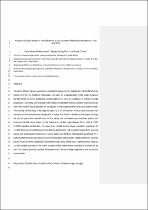 ResearchSpace
ResearchSpace
Analysis of spatio-temporal rainfall trends across southern African biomes between 1981 and 2016
JavaScript is disabled for your browser. Some features of this site may not work without it.
- ResearchSpace
- →
- Research Publications/Outputs
- →
- Journal Articles
- →
- View Item
| dc.contributor.author |
Marumbwa, FM

|
|
| dc.contributor.author |
Cho, Moses A

|
|
| dc.contributor.author |
Chirwa, PW

|
|
| dc.date.accessioned | 2020-10-05T08:53:59Z | |
| dc.date.available | 2020-10-05T08:53:59Z | |
| dc.date.issued | 2019-12 | |
| dc.identifier.citation | Marumbwa, F.M., Cho, M.A. and Chirwa, P.W. 2019. Analysis of spatio-temporal rainfall trends across southern African biomes between 1981 and 2016. Physics and Chemistry of the Earth, v114, 9pp. | en_US |
| dc.identifier.issn | 1474-7065 | |
| dc.identifier.issn | 1873-5193 | |
| dc.identifier.uri | https://www.sciencedirect.com/science/article/pii/S1474706519300658#! | |
| dc.identifier.uri | https://doi.org/10.1016/j.pce.2019.10.004 | |
| dc.identifier.uri | http://hdl.handle.net/10204/11591 | |
| dc.description | Copyright: 2019 Elsevier. This is the pre-print version of the work. Kindly contact the publisher's website for the published version. | en_US |
| dc.description.abstract | Southern African biomes experience significant changes in the distribution of rainfall that are linked to El Niño–Southern Oscillation. As such, an understanding of the spatio-temporal rainfall trends is key in predicting rainfall patterns as well as validation of climate change projections. Currently, the available information on rainfall trends in southern Africa is scanty with most studies focusing either on the spatial or the temporal dimension at localised levels. The novelty of this study is its regional aspect (i.e. all of southern African arid and semi-arid biomes) and the simultaneous integration of space and time in rainfall trend analysis through the use of space time rainfall cube. In this study, we simultaneously examined spatial and temporal rainfall trends based on the space-time rainfall cube derived from 1981 to 2016 CHIRPS satellite rainfall data. The space time rainfall trend analysis revealed a significant (P < 0.05) decrease of rainfall across most biomes particularly in the northern parts of the savanna biome and southwestern biomes (i.e. karoo, desert and fynbos). Statistically significant (P < 0.05) rainfall increase was observed in the central parts of the region mostly within the savanna biome. In terms of the magnitude of rainfall change, some of the areas experienced as much as 12 mm rainfall decrease in the mean annual rainfall while others recorded an increase of 14 mm. Our results provide baseline information for climate change adaptation and ecosystem conservation. | en_US |
| dc.language.iso | en | en_US |
| dc.publisher | Elsevier | en_US |
| dc.relation.ispartofseries | Worklist;23729 | |
| dc.subject | Rainfall trends | en_US |
| dc.subject | Biome | en_US |
| dc.subject | Climate change | en_US |
| dc.subject | Drought | en_US |
| dc.title | Analysis of spatio-temporal rainfall trends across southern African biomes between 1981 and 2016 | en_US |
| dc.type | Article | en_US |
| dc.identifier.apacitation | Marumbwa, F., Cho, M. A., & Chirwa, P. (2019). Analysis of spatio-temporal rainfall trends across southern African biomes between 1981 and 2016. http://hdl.handle.net/10204/11591 | en_ZA |
| dc.identifier.chicagocitation | Marumbwa, FM, Moses A Cho, and PW Chirwa "Analysis of spatio-temporal rainfall trends across southern African biomes between 1981 and 2016." (2019) http://hdl.handle.net/10204/11591 | en_ZA |
| dc.identifier.vancouvercitation | Marumbwa F, Cho MA, Chirwa P. Analysis of spatio-temporal rainfall trends across southern African biomes between 1981 and 2016. 2019; http://hdl.handle.net/10204/11591. | en_ZA |
| dc.identifier.ris | TY - Article AU - Marumbwa, FM AU - Cho, Moses A AU - Chirwa, PW AB - Southern African biomes experience significant changes in the distribution of rainfall that are linked to El Niño–Southern Oscillation. As such, an understanding of the spatio-temporal rainfall trends is key in predicting rainfall patterns as well as validation of climate change projections. Currently, the available information on rainfall trends in southern Africa is scanty with most studies focusing either on the spatial or the temporal dimension at localised levels. The novelty of this study is its regional aspect (i.e. all of southern African arid and semi-arid biomes) and the simultaneous integration of space and time in rainfall trend analysis through the use of space time rainfall cube. In this study, we simultaneously examined spatial and temporal rainfall trends based on the space-time rainfall cube derived from 1981 to 2016 CHIRPS satellite rainfall data. The space time rainfall trend analysis revealed a significant (P < 0.05) decrease of rainfall across most biomes particularly in the northern parts of the savanna biome and southwestern biomes (i.e. karoo, desert and fynbos). Statistically significant (P < 0.05) rainfall increase was observed in the central parts of the region mostly within the savanna biome. In terms of the magnitude of rainfall change, some of the areas experienced as much as 12 mm rainfall decrease in the mean annual rainfall while others recorded an increase of 14 mm. Our results provide baseline information for climate change adaptation and ecosystem conservation. DA - 2019-12 DB - ResearchSpace DP - CSIR KW - Rainfall trends KW - Biome KW - Climate change KW - Drought LK - https://researchspace.csir.co.za PY - 2019 SM - 1474-7065 SM - 1873-5193 T1 - Analysis of spatio-temporal rainfall trends across southern African biomes between 1981 and 2016 TI - Analysis of spatio-temporal rainfall trends across southern African biomes between 1981 and 2016 UR - http://hdl.handle.net/10204/11591 ER - | en_ZA |





